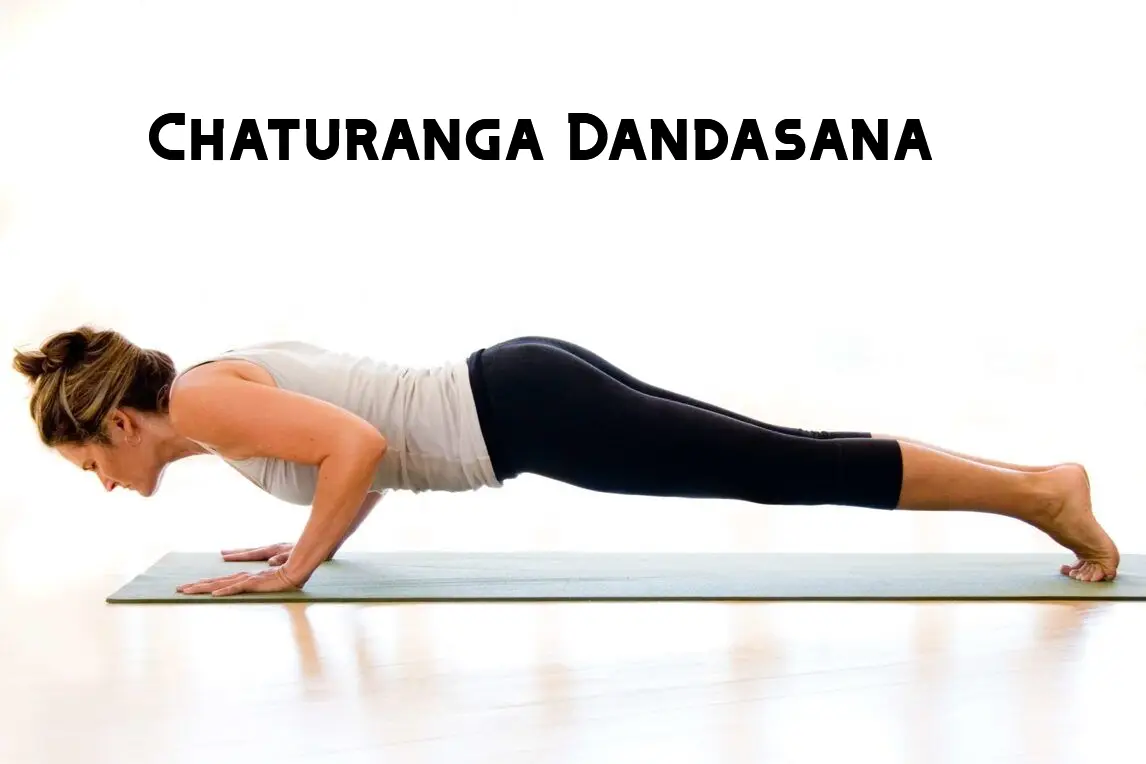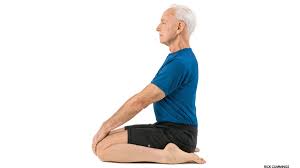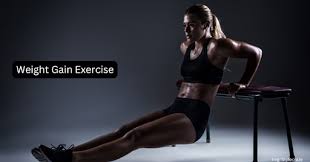Chaturanga Dandasana
Table of Contents
Introduction
Chaturanga Dandasana, commonly known as the Four-Limbed Staff Pose, is a fundamental yoga pose that forms a crucial part of the Sun Salutation sequence. The name “Chaturanga Dandasana” is derived from Sanskrit, where “Chatur” means four, “Anga” means limb, and “Danda” means staff or stick.
- Over the years, the yoga pose known as chaturanga dandasana, or low plank, has caused a great deal of distress to a great number of people.
- Discover the anatomical reasoning behind the assertion that there is a single correct technique to do this particular yoga pose.
- I’ll break down the chaturanga technique in this post using that anatomical knowledge.
- I’ll also go over the advantages and some of the most typical verbal cues.
- Physical fitness has gained importance recently, and individuals are beginning to draw connections between their physical mental, and spiritual well-being.
- Yoga is a type of exercise that promotes the integration of our mind and body.
- Yoga signifies “union” or “joining.”
- There are several yoga systems, and each system integrates distinct facets of the human experience in unique ways.
- Hatha Yoga is one such method that seeks to harmonize and integrate the body’s many energy streams.
- One of the asanas (poses) in hatha yoga is the sun salutation or Surya Namaskar.
- Chaturanga dandasana is one such asana performed during Surya Namaskar.
- Let us briefly go over some of the health benefits of Chaturanga Dandasana.
What is Chaturanga Dandasana?
- The sequence of asanas known as Surya Namaskar is executed with synchronized breathing.
- One of the stances done when doing Surya Namaskar is Chaturanga Dandasana.
- The pronunciation is Dahn-dah-duh-nuh or cha-you-Rahn-gah.
- The four-limbed staff position or low plank stance are other names for chaturanga dandasana.
- “That” means “four,” “anga” means “limbs,” “danda” means “staff,” and “asana” means posture in English.
- A pose called chaturanga dandasana is meant to increase strength.
How to do it?
Here’s how to perform chaturanga dandasana:
- With your hands pointed forward and your legs both behind you, assume the plank posture.
- Continue breathing normally.
- To feel the strain on your thighs, extend both of your heels.
- With your hands pointing forward and your head held straight, push the floor away from you.
- Maintain a low shoulder stance and keep your ears apart.
Chaturanga Dandasana Yoga Video
Benefits of Chaturanga Dandasana
The following are some advantages of chaturanga dandasana:
Chaturanga Dandasana’s Benefits for Back Pain
- Young women from various institutions in Ahmedabad claim that chaturanga dandasana can help to improve the stability and endurance of the lumbar region of the spine.
- Additionally, it may fortify the abdominal muscles and reduce the likelihood of experiencing back pain.
- To determine if chaturanga dandasana may lower the risk of back discomfort, additional research is necessary as this study was conducted on a modest scale.
- If you experience persistent back discomfort, you should see a doctor.
Advantages of Heart-Related Chaturanga Dandasana
- According to research conducted on healthy women, chaturanga dandasana may help lower heart strain by controlling stress levels.
- To find out if chaturanga dandasana can aid in heart protection, more research is necessary,
- If you exhibit any heart disease symptoms, you should see your physician.
Benefits of Chaturanga Dandasana for Increasing Flexibility and Maintaining Proper Posture
- Research on chaturanga dandasana was carried out in 2021.
- The study’s findings suggested that Chaturanga Dandasana might support the back’s and abdominal muscles’ ability to maintain a rigid, upright posture.
- Furthermore, it could strengthen and tone the muscles in the arms, shoulders, back, legs, and neck.
- Additional research is necessary to find out if Chaturanga Dandasana can aid with flexibility and posture.
Chaturanga Dandasana’s Advantages for Losing Weight
- According to a 2020 research, including chaturanga dandasana with Surya Namaskar might potentially facilitate weight loss.
- Chaturanga Dandasana’s bending and stretching movements might aid in the loss of adipose tissue, or fat.
- Nevertheless, further research is needed to determine whether chaturanga dandasana might aid weight management.
- To help you with an exercise program to help you lose weight, you should speak with your dietitian.
Chaturanga Dandasana’s Beneficial Effects on Blood Circulation
- The chaturanga dandasana pose of Surya namaskar may aid in enhancing blood circulation.
- It could lessen hair loss and increase blood flow to the scalp.
- Moreover, chaturanga dandasana could support improved skin blood circulation, which would maintain youthful skin.
- To determine if chaturanga dandasana can aid in enhancing blood circulation, additional research is necessary.
Chaturanga Dandasana’s Benefits for Cancer
- Breast cancer survivors might experience reduced tiredness and inflammation by using a yoga routine that includes chaturanga dandasana.
- Fatigue and inflammation are increased when sleep is disturbed.
- Chaturanga dandasana has the potential to alleviate weariness and inflammation by promoting better sleep.
- To be sure, more extensive research is needed to determine if chaturanga dandasana is beneficial to breast cancer survivors.
- Since cancer is a severe illness, you should seek medical attention and avoid self-medication.
Chaturanga Dandasana’s Advantages for the Respiratory System
- As per the 2020 publication titled ‘A Role of ‘Surya Namaskara’ For Good Health,’ chaturanga dandasana has the potential to enhance lung function.
- It can strengthen the muscles surrounding the lungs and open up the chest cavity.
- Consequently, Chaturanga dandasana may improve the lungs’ capacity and contractility.
- To determine whether chaturanga dandasana may help the respiratory system, more research is necessary.
Chaturanga Dandasana’s Benefits for Mental Health
- A 2014 research found that doing hatha yoga positions such as chaturanga dandasana can help reduce feelings of depression and anxiety.
- Additionally, it could lessen weariness and tension while enhancing mood.
- Larger-scale research is still needed to determine whether chaturanga dandasana can enhance mental health.
- If something is wrong with your mental health, you should see a doctor.
Risks of Chaturanga Dandasana
One possible concern linked to chaturanga dandasana is the following:
- When chaturanga dandasana is performed incorrectly, it can lead to lower back or wrist injury.
- Backbends, forward bends, and twists can all result in lower back injury.
- We can assess the risk factors and continue to exercise with caution under the supervision of a certified and experienced yoga instructor or yoga specialist.
Step-by-Step Instructions
- Start with some simple breathing and stretches on your mat.
- Usually, Chaturanga Dandasana is performed as a part of a more extensive sequence.
- Here, we’ll concentrate on Chaturanga and the positions that come right before and after it.

- Assume a plank posture, keeping your arms and legs extremely straight.
- Your shoulders are above your wrists and your feet are hip-distance apart.
- The head’s crown extends forward, while the heels press back.
- Your hips aren’t protruding or sagging; instead, you might draw a line from your heels to the top of your head.
- To keep your body straight during this exercise, your legs must be solid and your core must be activated (imagine pulling your belly button toward your spine).

- Move the plank forward so that the feet are on tip-toes and the shoulders are in front of the wrists.
- The secret to a safer Chaturanga is this plank posture that has been moved forward.
- To open up your chest via your upper arms, roll your shoulders back.
- Your head and neck will naturally rise somewhat from their flat posture as a result of this, but they will still be in line with your spine.
- Descend to Chaturanga.
- Hugging your elbows against the side of your body, bend them straight back.
- Contrary to what would happen in a regular push-up, they shouldn’t fly out to the sides.
- You will see that your forearms automatically take a perpendicular posture to the floor since your shoulders are already in front of your wrists.
- With the upper arms parallel to the floor, this position is excellent.
- Don’t descend any further than that.
- Rather than doing the entire movement as a fast transition from the plank to the Upward-Facing Dog (Urdhva Mukha Svanasana), pause and hold the posture at the bottom.
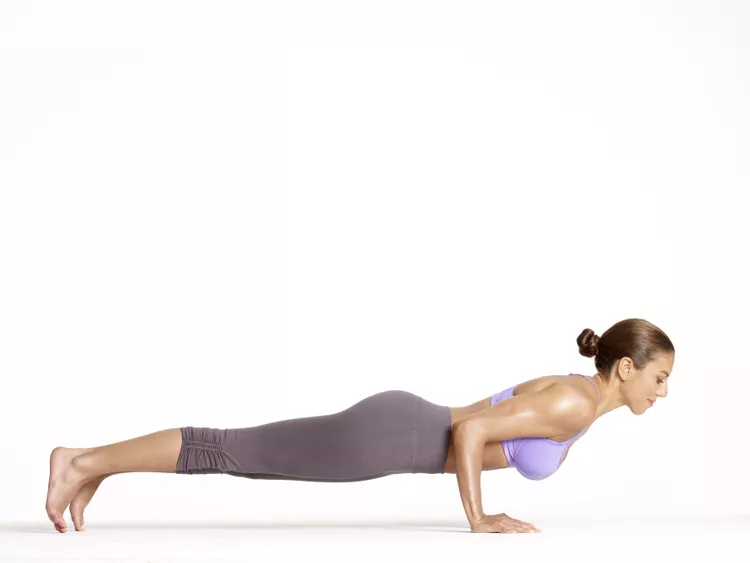
- Finish by switching to Upward Dog while maintaining a wide chest.
- Instead of hunching up by the ears, the shoulders stay back and down.
- Extend your arms and roll over your toes to reach your destination.
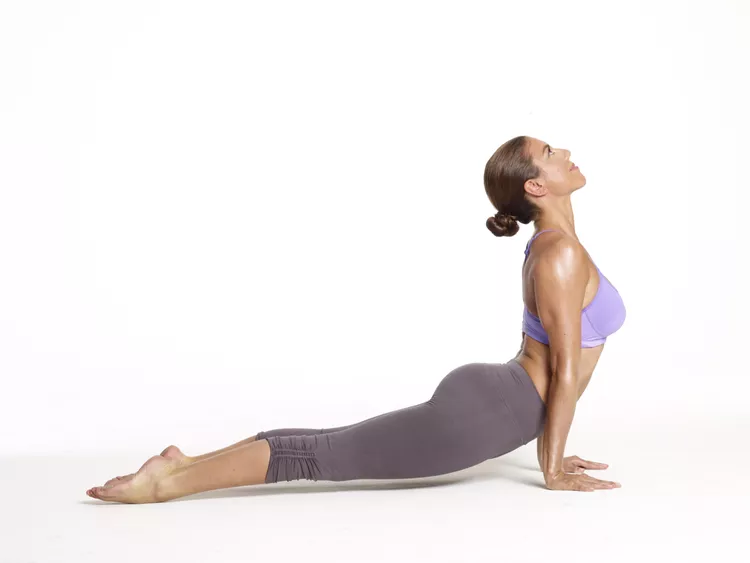
Common Mistakes
- Getting the Chaturanga posture exactly correct can be challenging, particularly if you are used to doing it with less-than-ideal form.
- Keep an eye out for these issues.
Shoulders Over Wrists
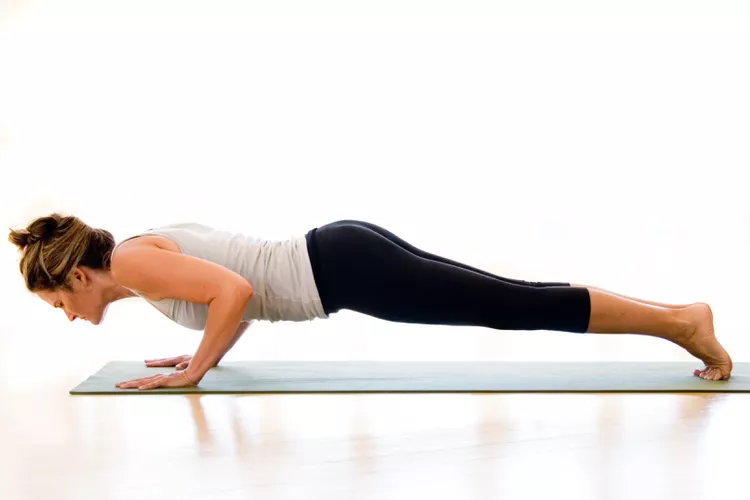
- Shoulders will hang over your wrists if you don’t rock forward from the plank before dropping into Chaturanga.
- Moreover, pushing back through your heels causes the shoulders to shift backward rather than forward.
- Consequently, your forearms will be on a diagonal when you lower yourself.
- The angled stance does not give the shoulders the support they need.
- Given that the arms and shoulders are the most vulnerable, give them priority and let the heels take their natural course.
Collapsed Chest
- The chest is pointing toward the ground in the image above.
- This should be fixed by opening up the chest in a plank position before dropping to Chaturanga.
Lowering Too Far
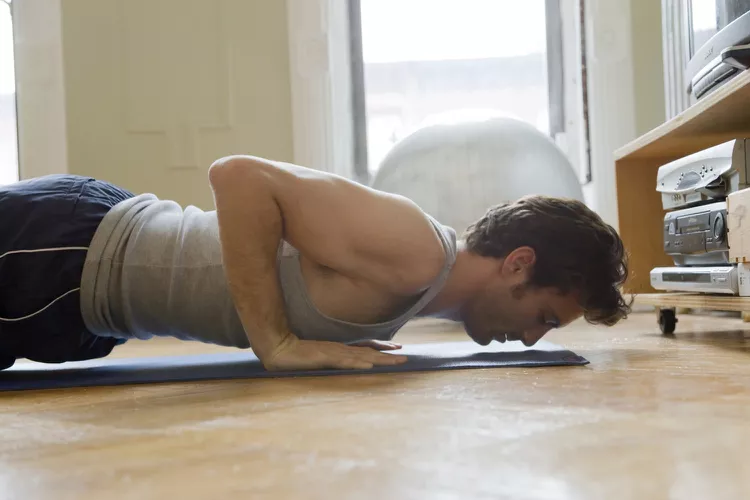
- Refrain from skimming as near to the ground as possible.
- You are placing a lot of strain on your wrists and shoulders when you allow your shoulders to drop below your elbows.
- When performed repeatedly throughout several practices, this type of wear and strain results in injuries.
- Maintaining the shoulder at or above the elbow is far safer.
- Try striking the stance in front of a mirror or ask a friend to help you if you’re unsure of how to position your arms.
- Stopping higher up may seem strange if you’re used to sinking low, but in the long run, it’s the greatest option for your shoulders.
Letting Hips Sag or Elbows Stick Out
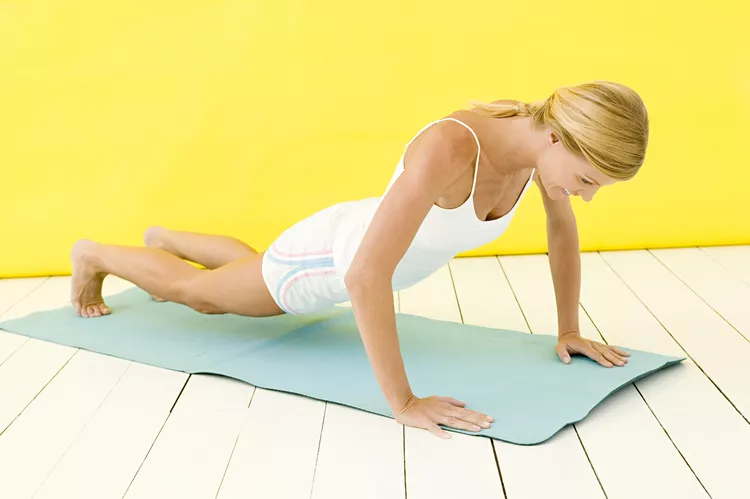
- Remember your fundamental alignment points at all times.
- You should lower your knees to the floor if your hips are drooping.
- To maintain your plank throughout the position, you must strengthen your core.
- Additionally, firmly hug your elbows into your sides.
- Depending on how wide your shoulders are, you could even feel them clutching your body when you’re hunched over.
Safety and Precautions
- As was already mentioned, alignment and form are crucial in avoiding shoulder problems.
- Speak with your physician or physical therapist about your treatment plan if you do have a shoulder injury.
- Likewise, you might need to modify your practice if you have any wrist discomfort or injuries.
- As your pregnancy progresses, modify your Chaturanga by bringing your knees down to the floor.
Conclusion
Surya Namaskara involves several positions, one of which is Chaturanga Dandasana. This chaturanga dandasana is also known as the plank position or the four-limbed staff stance. “That” means “four,” “anga” means “limbs,” “danda” means “staff,” and “asana” means posture in English.
The pose known as chaturanga dandasana is meant to strengthen the body. By increasing the lumbopelvic region’s stability and endurance, chaturanga dandasana may help lower the likelihood of back discomfort. It could aid with blood circulation, weight management, lung function, heart protection, and posture and flexibility improvements. The benefits of chaturanga dandasana may include a reduction in anxiety and depressive symptoms. Additionally, it could lessen weariness and tension while enhancing mood.
In breast cancer survivors, chaturanga dandasana may help with tiredness and inflammation reduction. When chaturanga dandasana is performed incorrectly, it can lead to lower back or wrist injury. As such, you have to do chaturanga dandasana under appropriate supervision.
FAQ
The four-limbed staff position or low plank stance are other names for chaturanga dandasana. ‘That’ means four, ‘anga’ means limbs, ‘danda’ means staff, and ‘asana’ is pose in English.
The Sun Salutations, which are the foundation of vinyasa flow yoga, need the practice of Chaturanga Dandasana, or Four-Limbed Staff Pose. This posture helps teach alignment, tones and strengthens the entire body, and gets you ready for a variety of other poses.
‘Asana’ refers to a stance, while ‘Danda’ is a staff or pole. For this reason, stick position or staff stance are also named for dandasana. The staff, which is sitting, is a representation of the strong, straight spinal column. Dandasana has several possible health advantages, including the ability to balance the body and lessen weariness.
Misaligned chaturanga can cause low back and neck pain, as well as rotator cuff problems and shoulder strains. Repeatedly doing a pose improperly increases the risk of developing injuries from repetitive motion, including rotator cuff, shoulder, and wrist problems.
The entire name of this yoga posture, chaturanga dandasana, is usually abbreviated as “chaturanga.” Another name for it is a low plank, however that term does not translate well from Sanskrit. We can understand the quality and shape produced by this stance if we dissect the Sanskrit.
References:
- Sankhe, A. (2023, July 26). Benefits of Chaturanga Dandasana and How to Do it By Dr. Ankit Sankhe. PharmEasy Blog. https://pharmeasy.in/blog/health-fitness-benefits-of-chaturanga-dandasana-and-how-to-do-it/
- Ryt, A. P. (2020, March 9). How to Do Low Plank (Chaturanga Dandasana) in Yoga. Verywell Fit. https://www.verywellfit.com/chaturanga-tips-for-your-shoulders-4065405

